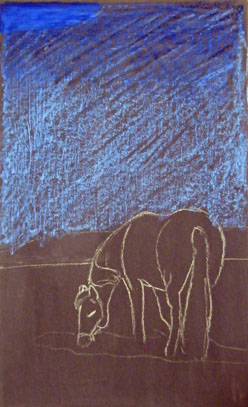Oil Pastel Tutorial
If you do have questions concerning oil pastel brands and other tools and materials, please read the FAQ first.
************
The painting shown here was done for the February 2008 Oil Pastel Challenge on WetCanvas. Thank you very much Angela for this beautiful shot!

The first thing I need to know before starting a painting is the composition. In this case I decided to put this little horse into a nightly landscape and in order to show more of the night sky I decided to work on a vertical format.
I know that there are plenty of artists out there who can start painting right away and will always get a gorgeous result, but I need to have made up my mind completely before I can start to paint. I need to see the finished piece clearly in front of my inner eyes.
The photo above shows you how I usually start the paintings: I transfer the most important lines using either charcoal or white chalk, depending on the color of my support. No details for me at this stage.
.
.

Next step is choosing the right colors for this painting. I’ve made a color chart for that purpose, since one cannot always tell the color from looking at the pastel itself.
There’s really no need to choose the same colors as in your ref picture, just make sure, that you choose corresponding values and that the colors you choose match well together. Most of my paintings have stong complementary contrasts, but not all of them. This one here is almost monochromatic as one usually does not perceive colors by night (without artificial lighting).
.

That’s what I came up with. Basically 3 colors: pale yellows, light pinks and two blues. The olive green is just meant for adding some darker accents where necessary.
.

Next step is blocking in the main colors of the background. I always start with the background that makes it so much easier to find the right color and value for the main subject. And as you will notice, too, when looking at the upper left corner I also start blending the OPs almost immediately as I like a smooth and even surface, almost like an oil painting.

That’s what the painting looks like after having blended all the colors in the background. Now I can start working on the horse. I decided to leave the dark color of the background as the darkest value on the horse and just added lighter colors where necessary and this was the result:


Wow ._.
Amazing (:
How Do You Blend The Oil Pastels So Good ?
I Use Pentel Oil Pastels … Its Pretty Okay .
I Love This Piece, Its Breathtaking 😀
Hi Anaa, actually it really depends what brand of oil pastels you are using when it comes to blending. Pentel Oil Pastels are quite hard and I don’t think they blend easily. Try working with softer oil pastels like Caran d’Ache Neopastel, Sennelier or Holbein Oil Pastels instead.
Or alternatively you could try using turps for blending. I’d still suggest softer oil pastels though ;D
Good luck with your paintings!!! 🙂
cool 😀
HI, I am wondering what was the surface you started with? Is pastel board black? Also when finished do you recommend any finishing spray to seal? Beautiful painting.
The surface was a self prepared pastel board. Basically I mix acrylics with pumice powder and then I coat the board 2 times with it. That way I cal always get the background color I’m looking for. In the case of this painting it was a dark violet color.
As for varnish, I do not really recommend any sort of spray. Oil pastel is a difficult medium and many people claim that it will never fully dry, so framing it behind glass would always be your safest option.
can’t tell if horse or cow…